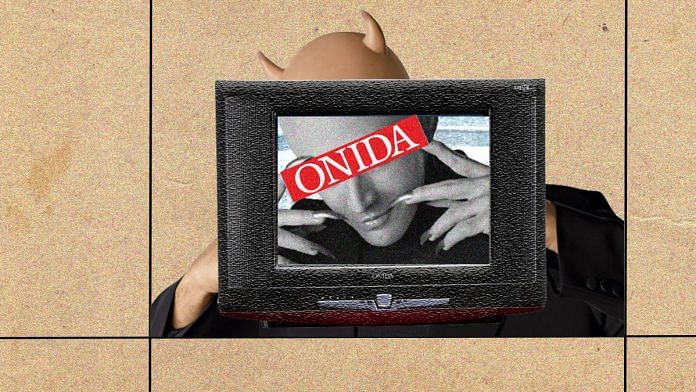A gloomy cave, a stone smashing the television screen, a green-coloured snake, cobwebs, spooky long nails, and a devil with horns and tail with a grimly mocking smile.
A radical advertisement in the 1980s evoked all these negative emotions to sell a brand-new television – Onida.
Onida TV’s advertisement and its iconic mascot, ‘the devil’, captured the imagination of Indian middle-class like few brands did. The pros and cons of the ad’s negative appeal was debated ad nauseum in the media, in living rooms and in the profession.
In an era of happy advertisements – young people dancing to ‘the zing thing’ in the GoldSpot ad, a groom’s father Shammi Kapoor saying he doesn’t ‘want’ anything in the Pan Parag ad, or Complan’s ad showing a little girl competing with the boy in gaining height – Onida went against the grain. And got noticed.
https://www.youtube.com/watch?v=JfIOGKHpziM
The company knows that it had invented a powerful brand mascot equivalent to Amul Girl and Air India’s Maharaja.
“In the annals of Indian advertising, Onida enjoys a storied past. The advertisements that Onida brought out broke all conventions and are a defining feature of the organisation. The company created amongst the most powerful icons in advertising, the Onida devil, and amongst the most memorable taglines, ‘Neighbour’s envy. Owner’s pride’,” says the company’s website.
Making the devil
In the 1980s, a television was the prized centrepiece of soberly decorated middle-class living rooms. Many homes did not have a TV set at all. And when they decided to buy one, they were spoilt for choice.
Onida was competing with a pool of brands including Oscar, Beltek, Weston, Nelco, Salora, Texla TV, Crown, BPL, and Videocon. To stand out from the clutter, Onida chose the shock-value route.
“At the time, Onida was a poor man’s Sony, and BPL and Videocon were ahead of us,” Krishnamurthy Sriram, vice-president at Mirc Electronics, the company which owns the Onida brand, had told Livemint. “But all these televisions were talking technical specs in their ads, which sounded like Latin and Greek to people.”
Also read: Crowning Glory: A soap that took on Indian sanskar with a little help from Dimple Kapadia
To solve Sriram’s quest for something different, Gopi Kukde, the art director of ad agency called Avenues, decided to reinvent the brand and turn it into a status symbol — and came up with a popular tagline.
Kukde convinced David Whitbread, a model coordinator, to play the role of the devil in the advertisement. “David has an unusual structure — he always looks naughty, as if he will come up with a prank in a minute or two. We wanted our devil to look cute and different,” Kukde told Livemint in an interview in 2009.
Why evil was beautiful for the brand
Onida’s advertisement came with a warning. “If you are a buying a television, don’t compromise. It will haunt you every evening,” said the devil in one of the ads.
Despite making ‘not-so-pleasant looking ads’ and using negative words like ‘envy’ and ‘haunt’, the brand struck the right chord.
“These ads single-handedly pushed the company’s market share from 5-6 per cent in 1981 to 19-20 per cent in 1995,” said Y.V Verma, former CEO of the company.
“Onida’s devil campaign was a brilliant idea accompanied with a brilliant looking product. While the technology of the television was more or less the same, Onida was definitely the master of styling (its product). While on one hand, the advertisement built the expectations too high, the product stood up to the expectations of the buyers,” said Santosh Sood, former chief operating officer at the ad agency, Rediffusion Y&R, which also handled the account of Onida post 2005.
“Making a brilliant advertisement does not define the success of the campaign. An advertisement proves out to be an icon if the product also stands up to the expectations. Otherwise, nothing kills a bad product as fast as a good advertisement,” Sood added.
An ad, after all, can help only so much with the publicity; it can’t turn the product into something that it isn’t – as was the case with Godrej’s Crowning Glory soap-cum-shampoo.
Fall and comeback of the devil
After Whitbread, many actors, including Rajesh Khera, Ashish Chaudhary, and Aamir Bashir, took upon the role of the devil.
The advertising agencies also changed hands — from Avenues, the creator of the campaign, to Ogilvy, and then to Rediffusion and McCann Erickson.
The devil worked for the company for almost two decades. In 2009, Onida wrapped up the mascot and announced a new campaign showing a married couple as protagonists.
According to Verma, the brand started to lose out in the global competition in the later stage. “When the brand was launched, television made neighbour’s envy, literally. There were not many houses with television sets in the 80s. Our tagline made sense.”
However, when Verma joined the company in 2013, the concept of buying a TV had changed dramatically. “Everyone had more than one television set and the competition from global brands was on peak. We decided to drop “neighbour’s envy” from our tagline because now everybody had a television set, it was no more a luxury and people started trusting foreign brands more than the local brands,” said Verma, who later joined LG India as the chief operating officer.
In 2016, Mumbai based creative agency Zero:Zero launched a new brand mascot for the brand, God – the opposite of devil. But alas, God didn’t last as long as the devil.
In 2018, the devil made the comeback, this time with an evil wife.




